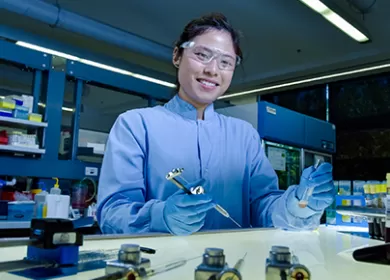Don’t have an account?
Select the donation type you’d like to make
Research study update: Understanding the anti-D immune response
This project is an exciting search for the holy grail of anti-D donor research: identifying the “secret sauce” in a person’s immune response that makes them produce anti-D antibodies, and replicating this in the lab.
Lifeblood and WEHI researchers are working together to investigate the immune response produced by our anti-D donors.
The ultimate goal is to create a new therapy, which could meet the needs of expectant mums but also reduce the need to boost and bleed anti-D donors.
What is anti-D and what is it used for?
Antibodies are naturally occurring molecules which can help protect you against infection and disease.
Anti-D is an important antibody product that’s used to help prevent a devastating disease, known as Haemolytic Disease of the Fetus and Newborn (HDFN). This disease occurs when a woman with RhD negative blood is carrying a baby that is RhD positive. The mother's immune system can recognise her baby's blood as a foreign invader and develop antibodies. These antibodies can then attack the blood of her unborn child, leading to miscarriage, stillbirth or other complications.
However, if given early enough to the mother, these same antibodies (which we call anti-D), can protect the baby by ‘mopping up’ the baby’s red blood cells before they stimulate the mother’s immune response against RhD.
Currently, we depend on the generosity of a small number of dedicated anti-D donors to supply the antibodies that are given to all RhD negative pregnant women in Australia to help prevent this deadly disease.
What did we do?
Thirty anti-D donors provided a blood sample to send to WEHI in Melbourne for the study. The WEHI team, led by Professor Ian Wicks, isolate the plasma fraction and a group of cells known as peripheral blood mononuclear cells (PBMCs). Some parts of each sample are specially frozen and stored for later use.
So far, our collaborators at WEHI have:
- Isolated specific cell types from the PBMCs and analysed their properties.
- Collected several hundred anti-D antibodies that bind to RhD positive red cells.
- Developed ways to test how the antibodies work by applying them to cells in the laboratory and measuring if the antibodies kill the cells directly, stimulate other immunes cells to “eat” them, or a combination.
- Established a way to watch live cells under a microscope to observe how RhD and red cells interact with immune defence cells, and how the interaction changes when anti-D antibodies are present.
What’s happening next?
Professor Ian Wicks and his team are optimistic that they’ve found a combination of antibodies that work comparably to the donor-derived anti-D product. The team are now considering clinical trials for a new lab-grown anti-D product, which is a complicated process given the eventual target population is pregnant women.
Meanwhile, the WEHI team continue to work on the samples provided by Lifeblood, and are using the new tests they’ve developed to further understand how anti-D affects the immune system to prevent HDFN.
Ultimately, we hope that the knowledge that comes from this study can improve the way HDFN is currently managed for pregnant women not just in Australia, but around the world.


